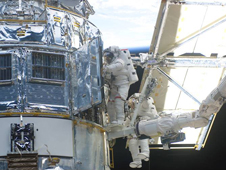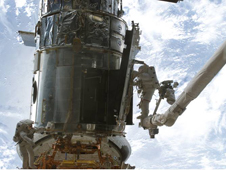The
Hubble Space Telescope, orbiting 353 miles (569 km) above the surface of the Earth, was the first telescope designed to be visited in space by astronauts to perform repairs, replace parts, and update its technology with new instruments. With
each servicing mission, Hubble's power increases, making it one of the most enduring and successful space missions ever undertaken.
There have been four previous servicing missions to Hubble:
Servicing Missions 1, 2, 3A and 3B. The upcoming
Servicing Mission 4 (SM4) scheduled for October 2008 will be the final trip to Hubble. The astronauts’ goals for SM4 are to install new instruments, replace degraded systems, and bring inactive instruments back to life.
Servicing Missions involve intensive coordination between Kennedy Space Center (KSC) in Florida, Johnson Space Center (JSC) in Texas, and Goddard Space Flight Center (GSFC) in Maryland. Preparation activities include astronaut training at all three centers; simulations of telescope operations during the mission at the Space Telescope Operations Control Center (STOCC) at GSFC; testing and preparing instruments and hardware for flight at GSFC; and preparing the space shuttle for launch, flight, and landing at KSC.
During the mission, operations take place primarily at JSC and the STOCC. JSC’s Mission Control Center (MCC) monitors every aspect of the space shuttle and astronauts, including spacewalks, procedures and schedules, crew activities and health, and in-cabin and cargo bay systems and experiments.
The STOCC ground crew handles telescope operations, sending commands to Hubble to place the instruments into “safe hold” (hibernation), close the aperture door which covers the precious optical components, and perform a maneuver to position itself for grappling by the shuttle’s robotic arm, operated by an astronaut, who will bring Hubble into the shuttle’s payload bay.
After each new system part or science instrument is installed, STOCC personnel perform tests to make sure each instrument and component has power and operates as it should. When the astronauts are sleeping, the STOCC performs more detailed tests on each newly installed component to determine if the astronauts need to perform additional work on it.
After all the servicing tasks have been performed, usually in a series of spacewalks over the course of 3 to five days, and Hubble is ready to be put back into service, controllers at STOCC and JSC Mission Control prepare the telescope for release. Often this also involves using the shuttle’s thrusters to climb into a higher orbit before releasing Hubble.
The crew then slowly and deliberately uses the shuttle’s robotic arm to raise Hubble from the payload bay and out into space, where controllers at STOCC open the aperture door and make sure the telescope is functioning on its own. At the right moment, the astronaut operating the arm releases Hubble back into its own orbit, and controllers in the STOCC continue bringing the world’s premiere observatory back to life and into science observations over the course of a few months.


 Two astronauts work on the Hubble during a previous servicing mission
Two astronauts work on the Hubble during a previous servicing mission  Find out all there is to know about the fifth and final servicing mission to Hubble
Find out all there is to know about the fifth and final servicing mission to Hubble